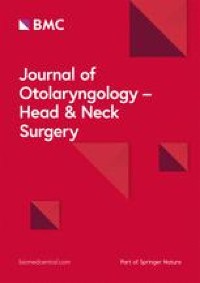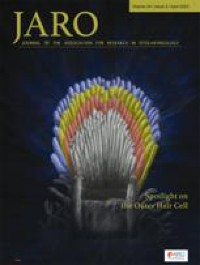|
Αρχειοθήκη ιστολογίου
-
►
2023
(391)
- ► Φεβρουαρίου (200)
- ► Ιανουαρίου (191)
-
▼
2022
(2843)
- ► Δεκεμβρίου (161)
- ► Σεπτεμβρίου (219)
-
▼
Φεβρουαρίου
(264)
-
▼
Φεβ 22
(11)
- Transcervical styloidectomy for Eagle syndrome
- Effects of a tongue training program in Parkinson'...
- Outcomes After Oral Cavity and Oropharyngeal Salva...
- The effect of extra safety measures on incidence o...
- Long-Term Voice Outcomes After Type I, Type II, or...
- Case report of unusual insertion of the fibularis ...
- How to manage Graves' disease in women of childbea...
- Clinical outcomes of a cohort of 271 patients with...
- Introduction and expression of PIK3CAE545K in a pa...
- Selumetinib Plus Adjuvant Radioactive Iodine in Pa...
- Cochlear Fluid Spaces and Structures of the Gerbil...
-
▼
Φεβ 22
(11)
- ► Ιανουαρίου (280)
-
►
2021
(5625)
- ► Δεκεμβρίου (231)
- ► Σεπτεμβρίου (345)
- ► Φεβρουαρίου (620)
-
►
2020
(2065)
- ► Δεκεμβρίου (535)
- ► Σεπτεμβρίου (222)
- ► Φεβρουαρίου (28)
-
►
2019
(9608)
- ► Δεκεμβρίου (19)
- ► Σεπτεμβρίου (54)
- ► Φεβρουαρίου (3791)
- ► Ιανουαρίου (3737)
-
►
2018
(69720)
- ► Δεκεμβρίου (3507)
- ► Σεπτεμβρίου (3851)
- ► Φεβρουαρίου (8116)
- ► Ιανουαρίου (7758)
-
►
2017
(111579)
- ► Δεκεμβρίου (7718)
- ► Σεπτεμβρίου (7549)
- ► Φεβρουαρίου (10753)
- ► Ιανουαρίου (10529)
-
►
2016
(16402)
- ► Δεκεμβρίου (7478)
- ► Φεβρουαρίου (900)
- ► Ιανουαρίου (1250)
! # Ola via Alexandros G.Sfakianakis on Inoreader
Η λίστα ιστολογίων μου
Τρίτη 22 Φεβρουαρίου 2022
Transcervical styloidectomy for Eagle syndrome
Effects of a tongue training program in Parkinson's disease: Analysis of electrical activity and strength of suprahyoid muscles
|
Outcomes After Oral Cavity and Oropharyngeal Salvage Surgery
|
The effect of extra safety measures on incidence of surgical site infection after alloplastic breast reconstruction
|
Long-Term Voice Outcomes After Type I, Type II, or Type V Cordectomy
|
Case report of unusual insertion of the fibularis brevis muscle
|
How to manage Graves' disease in women of childbearing potential
|
Clinical outcomes of a cohort of 271 patients with lung metastases from differentiated thyroid carcinoma
|
Introduction and expression of PIK3CAE545K in a papillary thyroid cancer BRAFV600E cell line leads to a dedifferentiated aggressive phenotype
|
Selumetinib Plus Adjuvant Radioactive Iodine in Patients With High-Risk Differentiated Thyroid Cancer: A Phase III, Randomized, Placebo-Controlled Trial (ASTRA)
|
Cochlear Fluid Spaces and Structures of the Gerbil High-Frequency Region Measured Using Optical Coherence Tomography (OCT)
|
Αρχειοθήκη ιστολογίου
-
►
2023
(391)
- ► Φεβρουαρίου (200)
- ► Ιανουαρίου (191)
-
▼
2022
(2843)
- ► Δεκεμβρίου (161)
- ► Σεπτεμβρίου (219)
-
▼
Φεβρουαρίου
(264)
-
▼
Φεβ 22
(11)
- Transcervical styloidectomy for Eagle syndrome
- Effects of a tongue training program in Parkinson'...
- Outcomes After Oral Cavity and Oropharyngeal Salva...
- The effect of extra safety measures on incidence o...
- Long-Term Voice Outcomes After Type I, Type II, or...
- Case report of unusual insertion of the fibularis ...
- How to manage Graves' disease in women of childbea...
- Clinical outcomes of a cohort of 271 patients with...
- Introduction and expression of PIK3CAE545K in a pa...
- Selumetinib Plus Adjuvant Radioactive Iodine in Pa...
- Cochlear Fluid Spaces and Structures of the Gerbil...
-
▼
Φεβ 22
(11)
- ► Ιανουαρίου (280)
-
►
2021
(5625)
- ► Δεκεμβρίου (231)
- ► Σεπτεμβρίου (345)
- ► Φεβρουαρίου (620)
-
►
2020
(2065)
- ► Δεκεμβρίου (535)
- ► Σεπτεμβρίου (222)
- ► Φεβρουαρίου (28)
-
►
2019
(9608)
- ► Δεκεμβρίου (19)
- ► Σεπτεμβρίου (54)
- ► Φεβρουαρίου (3791)
- ► Ιανουαρίου (3737)
-
►
2018
(69720)
- ► Δεκεμβρίου (3507)
- ► Σεπτεμβρίου (3851)
- ► Φεβρουαρίου (8116)
- ► Ιανουαρίου (7758)
-
►
2017
(111579)
- ► Δεκεμβρίου (7718)
- ► Σεπτεμβρίου (7549)
- ► Φεβρουαρίου (10753)
- ► Ιανουαρίου (10529)
-
►
2016
(16402)
- ► Δεκεμβρίου (7478)
- ► Φεβρουαρίου (900)
- ► Ιανουαρίου (1250)




